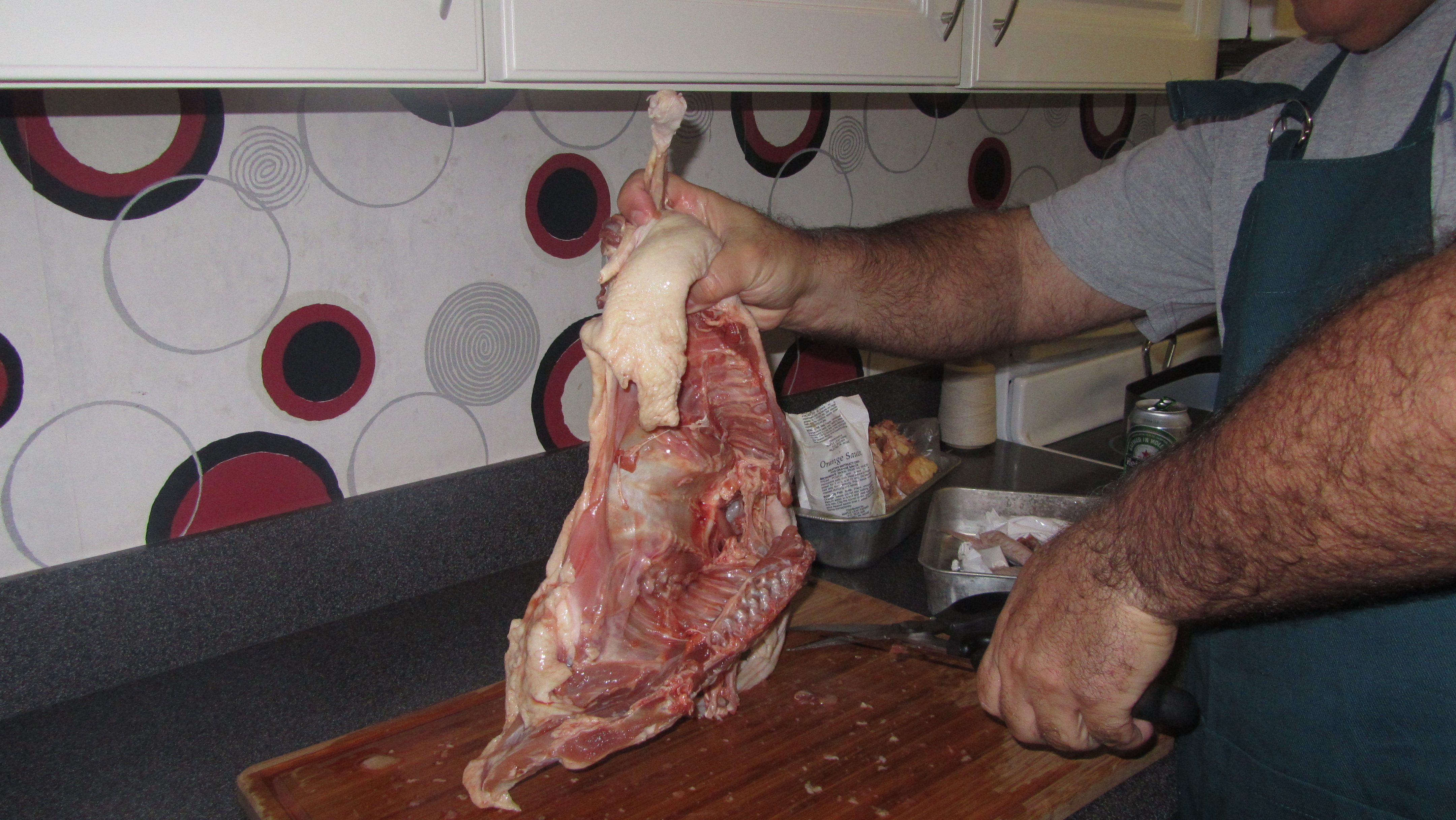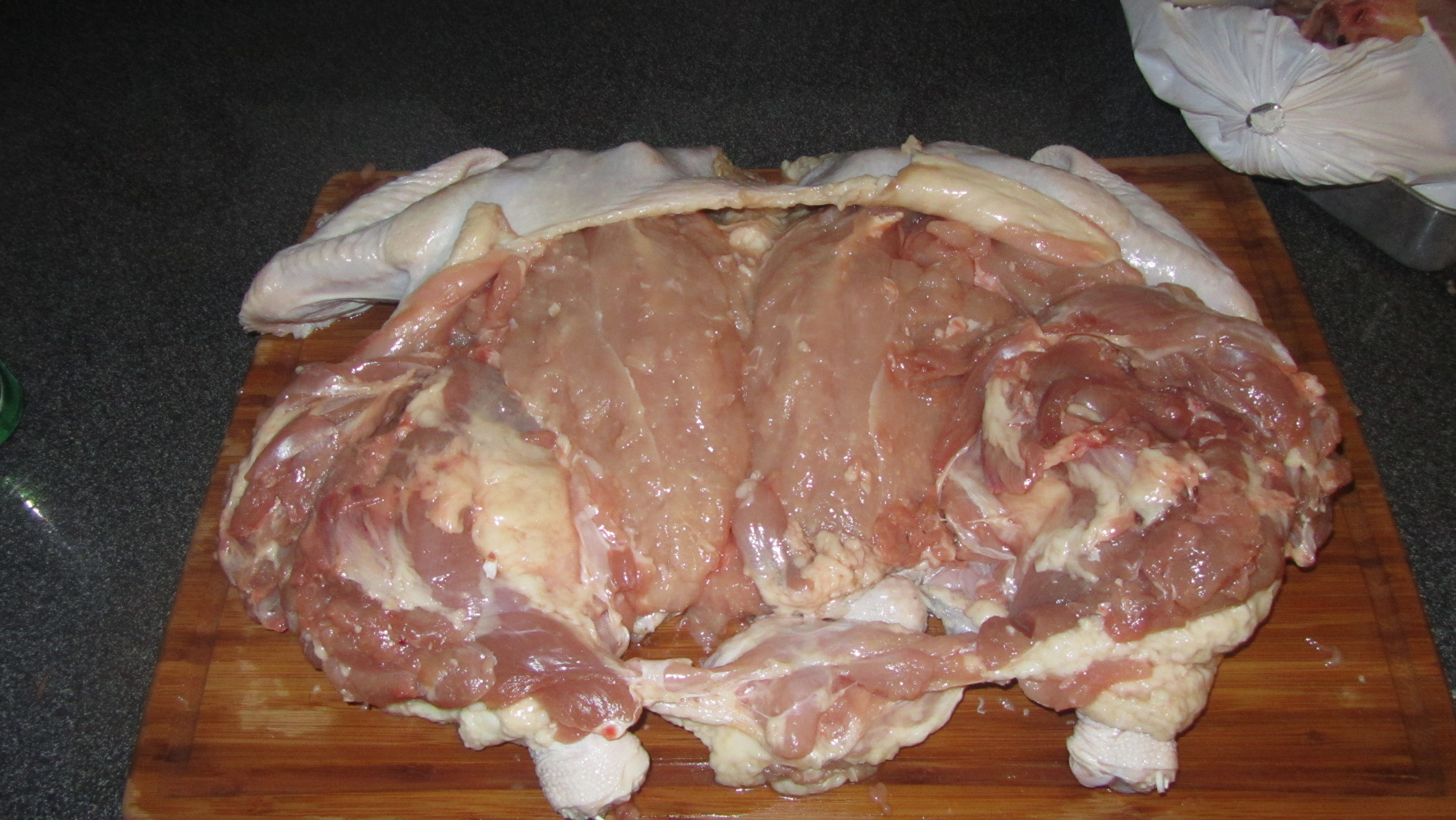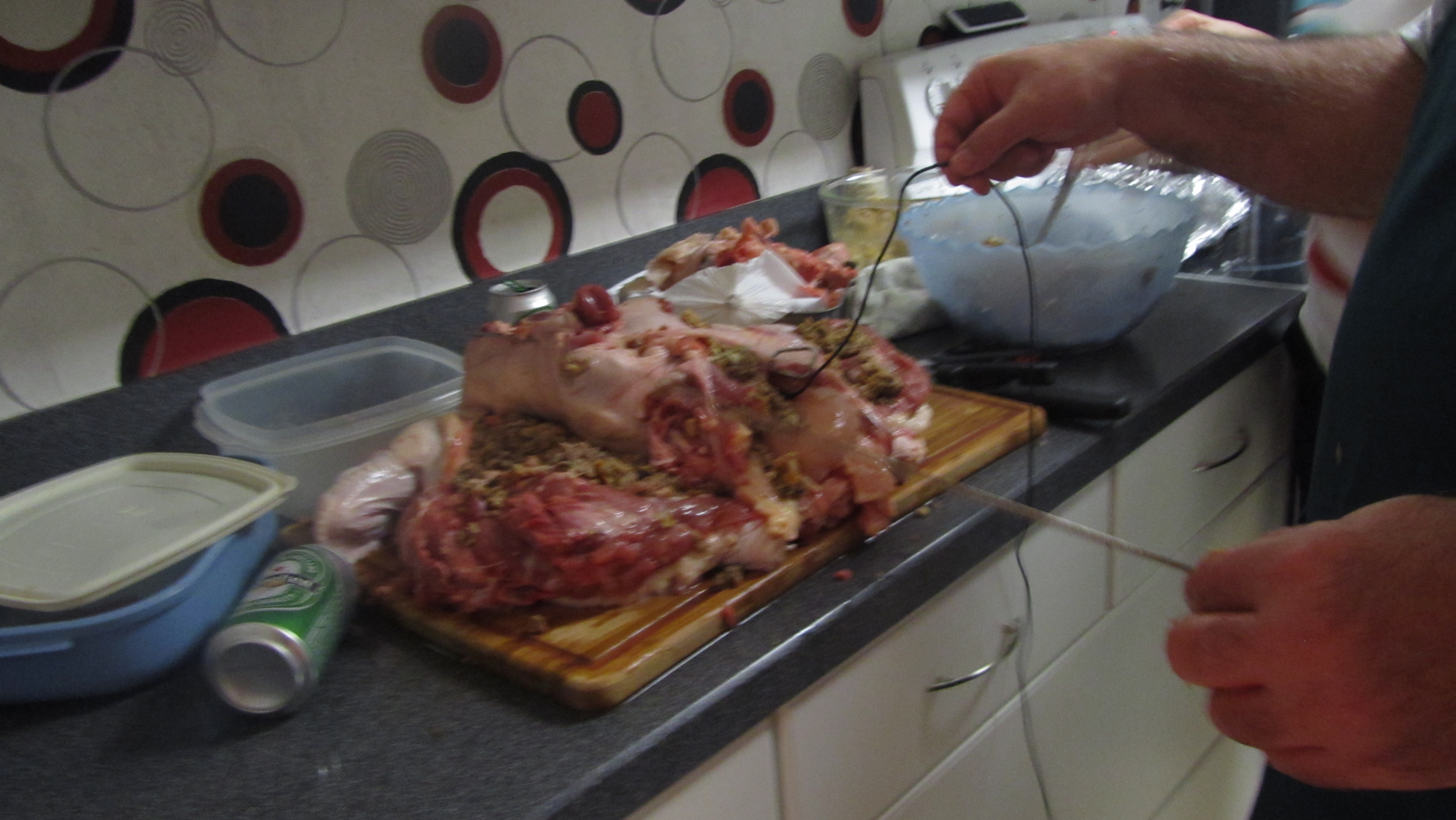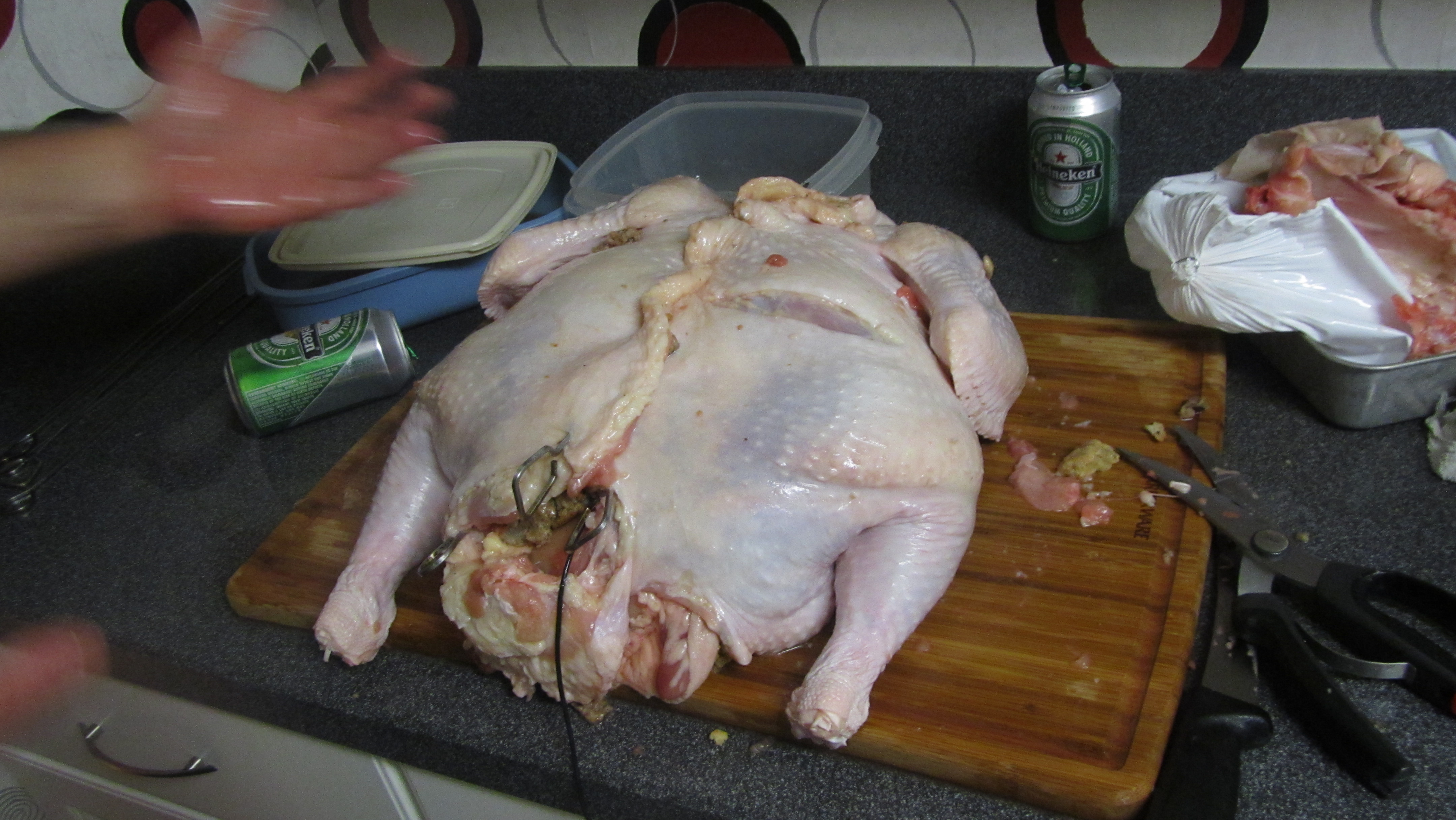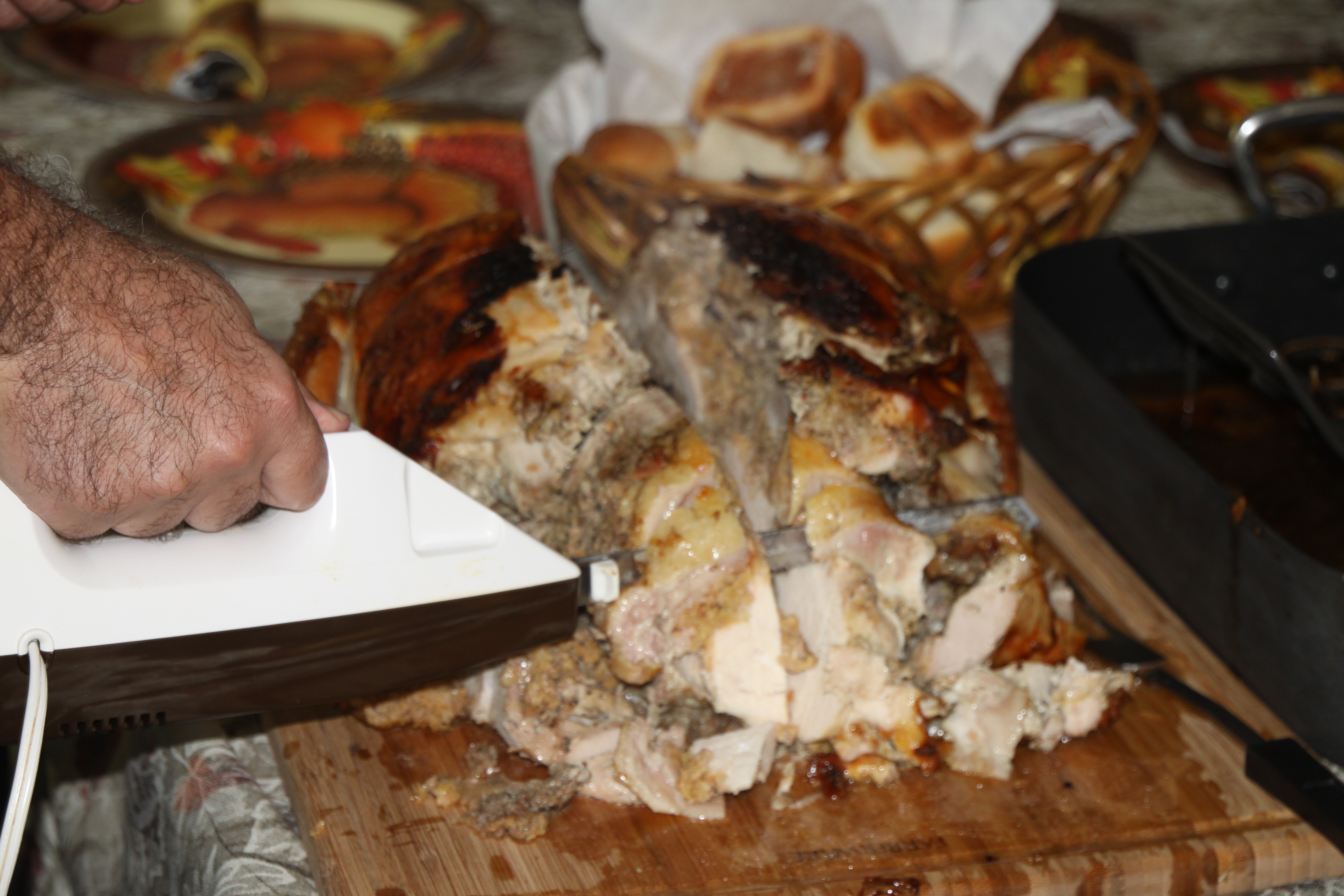Turducken, Steve’s way
Yesterday I made a near perfect turducken. This is the account of how I did it right on the first try, sort of. There are many online recipes that instruct you on when to add a pinch of this or cup of that. I’m not a strict recipe follower, and read several dozen, taking tips from the best of them and developing my own turducken training program and philosophy. There are also numerous horror stories and disappointments online, I’ll share my theories on why they failed and how to avoid same.
Cooking was one of the dozens of professions and trades I dabbled in before I found my vocation in technology. I cooked on oil rigs and supply boats and was never tossed overboard, and worked stints at gourmet destinations like Howard Johnsons, Perkins and Bonanza. I consider myself a fairly good cook and grillmeister. However, now that it’s just the two of us at home, we tend to have pretty simple meals, usually just ‘protein and greens.’ We have a lot of steak and salad, fish and green beans, chicken and broccoli…all good stuff, but not very complex. To don my apron and get out the good knives, I need a crowd before I’ll put the time into the big efforts. Good thing we have families and holidays to provide the crowd.
Despite my years of experience, I had never de-boned poultry before. There are many examples to watch on YouTube, I watched at least a dozen. I don’t recall that any single one stood out as best, and used them more for a sense of the task ahead than step by step procedures to be followed rigidly.
The right tools are essential for a job of this magnitude. The boning knife from MegaLoMart that came in a wooden block along with 11 other knives and scissors wasn’t quite up to the job. I hit Amazon and sprung for some Henckels. I have some good Oxo poultry shears that I bought to cut up chicken wings, which turned out to be critical to the process. I used our cheapo poly cutting boards for my trial runs on the small birds, and bought a large wooden Farberware board for the big day. Unfortunately it split in half after two uses, so no more $20 cutting boards for me, I’ll find a good one before I do this again. Too much is at stake to trust an aluminum foil baking pan, Oneida has a hard anodized roasting pan with rack for $40, I like it. The most important tool is the thermometer, but more on that later.
We roast a couple chickens a month. How many meals render dinner for two and lunch the next day for $7? For my first de-boning attempt I got a standard 5 pounder. I set my laptop on the counter with a YouTube video cued up, and put my mouse in a baggie so I could watch, pause, work, then watch some more without getting chicken schmutz on the mouse. That worked for a few minutes, until I got a feel for the process and winged it from there. I initially thought using shears was somehow ‘less professional’ than using the knife, but I got over that quickly, saving considerable labor. I won’t give a blow by blow on how to de-bone the chicken; the videos are more effective than I could be in text, except for one point. On the first bird, I used the knife to slice the skin down the back, then peeled back an inch of skin and used shears to cut through both sides of the backbone. On the second bird I only cut down one side of the backbone,then used it as a handle while I worked. I didn’t see that tip anywhere. My first chicken was pretty hacked up, but the bones were gone and the skin was mostly intact. I rubbed some lemon pepper inside, rolled up the chicken, stitched a long metal skewer through the skin, and added more lemon pepper on the outside. An hour at 425 degrees and we had a pretty good dinner to show for perhaps an hour of butchery. There’s no reason it should have tasted different or better than our standard roasted chicken, but somehow it did.
A week later I looked long and hard at the boneless chicken in the grocery, then got another roaster and did it again. Thankfully it went a bit faster and easier this time, as that was the entire point of my training regimen. It was time to step up, and we got a 4.5 pound duck from our favorite German meat market. I’d prepared duck precisely zero times before, so it was all new territory from here. The anatomy is the same from bird to bird, but the duck was more difficult to de-bone. There’s far less meat and far more fat and skin. However, I followed the same process as the chicken, and managed to keep it in all in one piece. It’s surprising how little meat was in the duck, but I got the skewer out again, and with a bit of sea salt, coarse black pepper and a few herbs it yielded dinner for two. Some of the fat came out crunchy and delicious, but more was in the pan in the form of duck oil.
I’d now done three practice de-boning runs, and the big day was approaching. I continued researching, and read many recipes. Paula Deen’s recipe seemed workable, and I was excited (for about 10 seconds) when I saw it called for only 3 hours in the oven. I thought that couldn’t be possible, so I read through the comments and the horror stories from people who took her at her word. I knew I could not cook a turkey in 3 hours in the $499 Kenmore oven in my kitchen. Paula Deen may have the best industrial convection oven in the world, but most of us don’t, and shame on her for not making that clear. To be fair, the folks that believed that would work must be somewhat naive. I decided not to follow any particular recipe, but an amalgamation of them all.
My research convinced me there are three potential causes for disappointment with turducken. The first is reliance on a retailer of a pre-made dish. Indications are that quality will vary wildly even with the same vendor. The meat to stuffing ratio could be off, or the workmanship is shoddy, or there are shipping errors, or the instructions don’t seem accurate. I’m sure some do a great job, at least part of the time. But I won’t bet my Thanksgiving on it. My solution is to do it myself.
The most prevalent issue, with both retail and homemade, is temperature. Once my birds were de-boned and assembled, they came to 29 pounds. Stories of raw centers and dry top layers are common. My solution was the best kitchen gadget I’ve ever bought, a $40 Oxo Digital Leave-In Thermometer. This has a metal probe that you put in the meat, a thin cord that you close the oven door on, then attach to a digital readout that fits neatly on the oven door handle. With this, we knew the exact temperature of the center and never opened the oven door. Without this thermometer, all my other work could have been for naught. It might seem expensive, but I’m sure I’ll use it many times, and if we go to your house for Thanksgiving I’ll let you borrow it.
The third cause for error is less specific; let’s just call it user error. Butchery, assembly, ingredients, baking and timing can all go wrong. I’m not a chef, but have enjoyed making food ever since 1976 when the cook at HoJo’s didn’t show up, and I got promoted to king of Friday night all-you-can eat fried clams. This was to be the most complicated single dish I’ve ever made, pushed my skills to the max, and taught me a few new ones. If you’ve got the chops to pull this off, it can be quite gratifying. If you don’t, you shouldn’t risk ruining a holiday with an experiment.
Finally, time to make the bird. I took the day before Thanksgiving off work, figuring on 5 hours de-boning and assembling. I started with the chicken. One of the tips I’d read frequently was that the skin of the inner birds did not get crispy, and some cooks recommended removing it to avoid a rubbery layer. Do you know what you get when you remove the skin from a de-boned chicken? Boneless, skinless chicken quarters. Next time I’ll save myself an hour, and buy the chicken that way, it will not impact the end result at all.
Next, the duck. Our German butcher carries frozen ducks year round, generally 4-5 pounds, but there were none at the grocery store. A week before Thanksgiving, Publix suddenly had a supply of ducks and geese, and we bought a 7 pounder. They probably always stock them for holidays; I’d just never paid attention before. (Goose…hmm). The larger duck was easier to de-bone, though still the most difficult. My theory on the duck skin and fat was the opposite of the chicken. I wanted the fat to melt into the turkey meat, basting it from within. I’d not seen this combination of techniques anywhere online, and sit here today quite pleased with myself for devising it. I’m sure someone else has done it, but I arrived at this hypothesis independently, and will patent the idea if I can make any money from it.
To my surprise, the turkey was the easiest to de-bone of them all. The bones and cartilage were harder and more distinct from the surrounding flesh and muscle, and the ribs came out almost intact. I left the drumsticks and wings in place to give the external appearance of an ordinary bird, taking care to get the bone cleaned out all the way to the “shoulder socket” so they’d pull off neatly. I was exceedingly cautious around the skin, as leaving it intact was essential for the external presentation. Without the practice on the first five birds, I could not have done it.
With long metal skewers and cooking twine close at hand, I began assembly. With the turkey skin side down on the cutting board, I covered it with herb and onion stuffing, which I schmooshed down to a half inch layer. (Sorry to get so technical, but the thesaurus does not yield another word to describe schmooshing accurately) I then placed the duck on the turkey, and added a layer of simple cornbread stuffing, upon which I laid the chicken. CRITICAL: I inserted the thermometer probe into the thickest part of the chicken breast, centered it both vertically and horizontally, and strung the wire down tail.
Pulling the duck skin up and around the chicken, I then used a long skewer to stitch the duck skin from tail to neck. Calling for help from my lovely wife, we pulled the turkey around the duck, and I used 3 skewers from varying angles to stitch it together.
I tied the cooking twine to a wing, and encircled the body 6-7 times as tightly as we could. We flipped the bird into the roasting pan and rack, now breast side up. Tied the drumsticks together, plopped on the sofa and had a Heineken. (It may not have been the first)
Regarding stuffing, there are as many stuffing recipes and traditions are there are cooks. For the turducken, I think of the stuffing as a way to garnish and flavor the inside, more than as a side dish. My research indicated excessive stuffing as a potential cause of failure, so I went minimalist inside the bird and we made plenty on the side in a separate casserole dish. Many recipes call for salt, pepper, herbs and a variety of spices on the meat, while I relied on the stuffing and the duck fat for internal flavoring. It worked.
Baking time and temperature is the biggest variable in the recipes I found. I decided that “low and slow” was the best way to get the center cooked without drying out the exterior layer. The turducken weighed in at 29 pounds. Figuring on 20 minutes per pound at 220 degrees, this came to about 10 hours. I set the oven to preheat to 450 at 2:45 AM, and set my alarm clock for 3:00 AM. Woke up as planned, put the birds in the oven, closing the door on the thermometer cord and plugging it into the digital display. I turned it down to 220 degrees and went back to bed with the door open, so I could hear the smoke alarm if it went off. Got back up at 3:30 AM, who can sleep with something this important happening? We watched the temperature rise on the external thermometer, until it was at 150 with 90 minutes to go. I decide to turn the oven up to 240 degrees, and declared it done about 1PM at 168 degrees. I made my sole error of the day, as looking through the oven window I decided to put the oven on Broil and brown the skin for a couple minutes. I scorched the skin and it was probably unnecessary. Pulled it out and draped it with foil, and let it rest for 30 minutes.
I can’t overemphasize the value of the internal probe and external thermometer. I did not want to open the oven and have it cool while checking the bird. I had planned all along to turn the oven up or down as needed in the final hours, and was able to do just that.
While my wife and daughter watched and helped me create the turducken, none of our 17 guests knew we were having something other than a ‘plain’ turkey. As I am a show-off, I elected to carve and unveil the surprise in the middle of the three tables stretching across the dining and living rooms. I pulled off the drumsticks and wings by hand, no knife required. I removed the skewers and string, then sliced down the center from neck to tail with an electric knife, and the sides fell apart into a V shape.
Starting at the tail, I sliced it into half ‘rings,’ with a mix of all three meats, dark and white, in each ring. For the most part the stuffing glued the half rings together which went on the plates intact, each half ring being a good serving size. I sliced the rest of it and filled two plates 4 inches high with meat.
There are meals, good meals and great meals. I humbly submit that this is the best I’ve ever done, and everybody was very happy with the result. With the friends and family in attendance, we’d have had a great day regardless, but it was worth all the effort to deliver a dish that will be talking about and remembered for years to come. I don’t know who, if anyone, will read this. But cooks like to share, so it would please me if this helps anyone make a memorable meal of their own.
